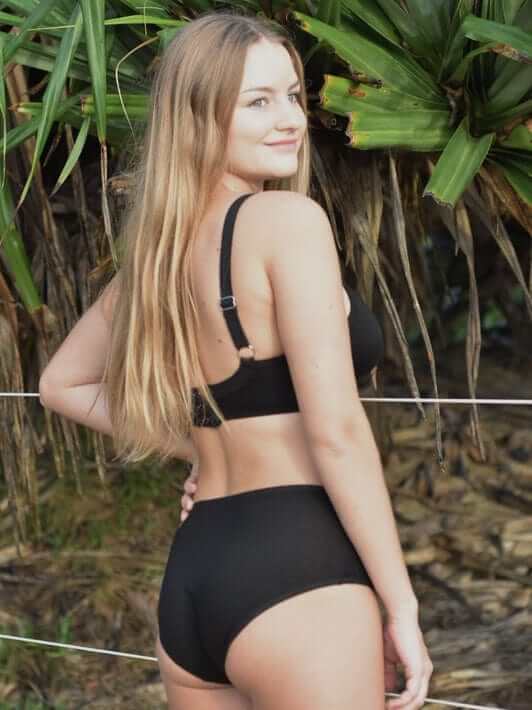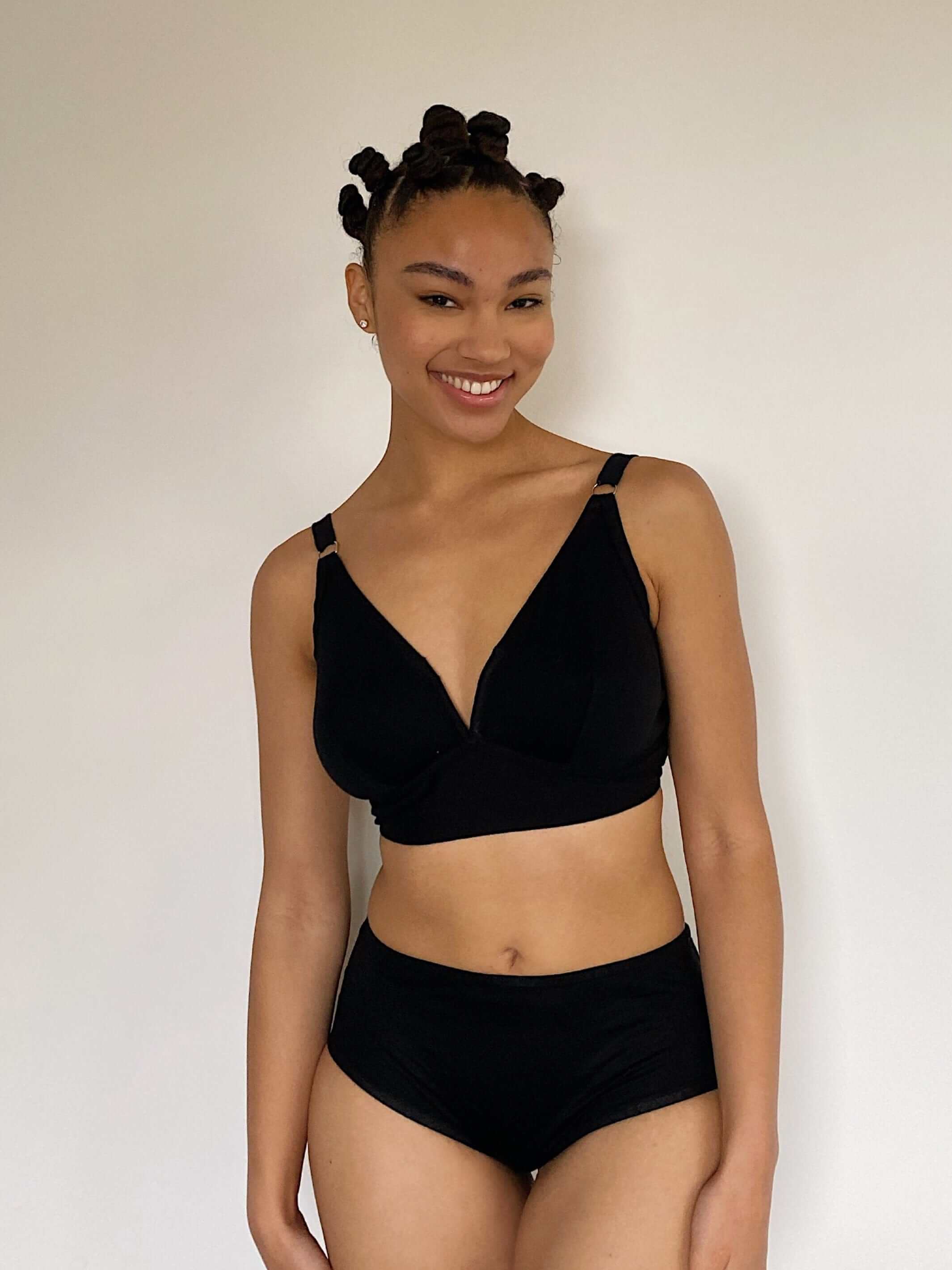The below is a guest blog from our good friends at Sustainable Jungle who've quietly backed and supported The Very Good Bra since our launch almost 5 years ago. This blog is based on our conversations around my work with the industry developing an end of life composting option for natural textiles, an Australian Standard which will provide an accessible and repeatable testing methodology so the good guys get composted and good consumers don't get greenwashed. It also leads into why we are working so hard to launch our plastic-free nursing bra in the next 6 weeks.
Compostable Bras: The Future Of Sustainability & Breast Health
Have you ever found yourself staring at a drawer of faded fabric and misshapen cups wondering what to do with your old bras?
If only there was a more responsible way to dispose of the friends who have supported us for so long.
Fortunately, there is, thanks to an ever-growing industry of sustainable bra-makers out to support the planet as well as your girls.
And the best of the best are compostable bras, or ones made entirely of natural fibers and plant-based substances that can completely return to nature once we’ve stretched out their lives (and straps) far enough.
Despite their clear advantages both from environmental and human health perspectives, there are more than a few bumps standing in the way of letting compostable bras live up to their full potential.
Let’s dive into how The Very Good Bra is tackling them.
The Problem (or Rather Problems) With Plastic Bras
You’ve probably heard the news by now, but that bra you’re wearing may be doing more damage than just pinching and poking you with its underwire.
Recent evidence has shown most synthetic sports bras—from major name-brands such as Nike, The North Face, PINK, Athleta, and more—contain BPA levels that exceed the maximum allowable amount per California’s Proposition 65.
But what’s all this buzz about BPA? We know our eco-friendly water bottles should be BPA-free but why is that?
BPA is a known endocrine disruptor, and, being estrogenically active, can be particularly devastating to the hormone pathways in women. By altering reproductive organ function, puberty, and ovulation, there is evidence to suggest it may even be linked to infertility.
When heated, BPA can leach chemicals into surrounding substances, meaning your food when microwaved in a BPA plastic container (hence our insistence on plastic free food storage) or (you guessed it) your breasts when getting a little hot and sweaty in your synthetic bra.
Beyond the negative health effects synthetic bras can have on the wearer, they can also spread these effects to others—namely, nursing infants.
BPA is widely found in breastmilk, and higher concentrations of BPA have been shown to negatively correlate with the infant’s growth rate and positively correlate with BPA levels in infants’ urine.
Environmentally speaking, plastic bras are no better.
The very creation of synthetic fabrics necessitates virgin petroleum mining, and all the land, water, and air pollution that comes along with it.
While opting for recycled synthetics (as are used in many more sustainable sports bras) prevents this, it doesn’t put a stop to microplastics a bra sheds into the water table each and every time it’s laundered. While a GuppyFriend or similar microplastic catching wash bag can help, they’re not perfect—especially given how imperfect humans are at consistently using them. These bras are also unable to be recycled twice so will end up in the landfill.
Bra waste statistics are especially troublesome in light of those that are only used for a short period of time, such as teen bras, bras for transitioning trans folks, and again, nursing bras.
Women go through an average of three nursing bras during the breastfeeding period. When accounting for the 3.6 million babies born in the US alone in 2021, a compostable alternative has the potential to divert nearly 10 million bras from landfills—not to mention prevent the pollution of petroleum mining required to create synthetic fabrics.
That’s why in February of 2023, The Very Good Bra will launch the world’s first compostable nursing bra on Kickstarter—in over 20 sizes! It will be made of unbleached, undyed organic cotton with entirely natural thread, elastic, and labeling.
You can now sign up to stay updated on the launch.
But offering compostable bras for all is only this company’s first step toward changing the bra industry for the better. Next, they aim to make the ability to actually compost them far more accessible.
Why Can’t We Compost Bras? What’s the Solution?
First, to be considered compostable by FTC guidelines, a product must be entirely made of natural materials (i.e. organic cotton) and be able to eaten by worms or break down completely into “usable compost” (i.e. no toxic residue) “in a timely manner”.
The “timely manner” is defined in relation to the materials with which it must break down. This is why home composting standards allow for more time than high-heat industrial settings.
These loose and widely interpretable guidelines not only leave room for greenwashing—AKA brands marketing their clothing as “compostable” when in reality it isn’t—but actually impede our ability to compost textiles at all.=
Currently, no country in the world offers the infrastructure to compost textiles commercially or industrially. While textile collection bins have become increasingly commonplace in urban areas, these only give us the means to recycle old clothes, but not compost them.
So though The Very Good Bra’s products can safely be tossed in a backyard or indoor compost bin, there is no composting solution for those who do not have access to these.
This means the only end-of-solution for otherwise fully compostable products is still the landfill, along with 600,000 tons of textiles from Australia alone.
Due to risk of contamination, commercial composting companies cannot accept products to compost that do not bear an Australian Standard (AS) certification to confirm it can break down completely in under 21 days.
Currently, the only composting standard to exist in Australia is AS5810 certification, reserved for bioplastic packaging.
The development of an AS for textiles rests on figuring out an exact set of lab-testable parameters fabric would need to meet in order to break down completely alongside things like food—adding needed carbon-rich matter to otherwise largely nitrogen-rich compostable materials.
One example of these parameters includes the size of fabric shreds (and how these might differ between various natural fabrics) needed to ensure decomposition within the allotted time period.
It would also test for chemicals, ruling out fibers processed with caustic and harmful substances, and even washing powders and softeners that can lead to chemical build-up over time.
Once a standard is developed, brands will individually need to obtain the certification by sending their garments in for testing to ensure it meets all compostability and anti-contaminant standards—down to the labeling, dyes, and threads.
What a Composting Standard Would Mean for the Future of Textiles
Despite the fact that it’s still in the development phase, why would the development of an AS standard matter and how would it help slow fashion and, more broadly, the sustainable fashion industry?
While this exact standard in development would only apply to Australian composting services, it would set a precedent for the rest of the world.
By providing a scientifically-backed and tested template, other countries (like the UK and US, both of whom are also responsible for massive amounts of textile waste) could more easily follow suit in developing their own commercial composting standards for textiles.
The timeline for success in this endeavor is unknown, but in the words of The Very Good Bra’s founder, “We’ve got to start somewhere.”
Final Thoughts on Compostable Bras
Feminism is the future, but don’t burn your bras; compost them!
If you don’t have the means to do so yourself, hang onto them until you find a friend or farmer who can—or until the service hopefully becomes available in your municipality.
Be sure to check back on this space to stay abreast of The Very Good Bra’s progress in pioneering the world’s first textile composting standard.
Until then, ditch your plastic push-up and check out their range of compostable bras. Hopefully by the time it needs replacing, these much-needed services will be widely available to more people!










